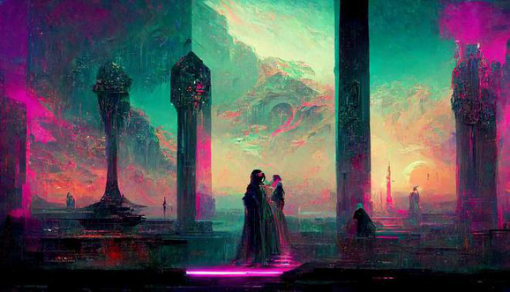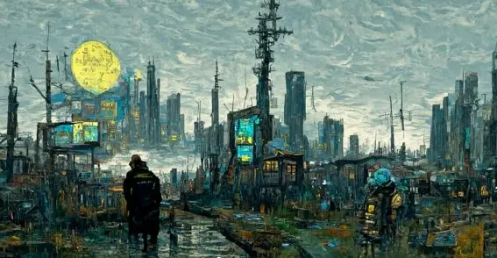
After AI has successively conquered problems such as chess, speech recognition, and text translation, AI-generated paintings are nothing new. The ability of AI to paint has begun to appear many years ago, and many technology companies are currently deploying in this regard. As early as a few years ago, painters used Paintschainer to colorize the line art drawn by themselves through the computer, and the effect achieved can already catch up with some relatively simple artificial coloring works (Ren, 2019). In addition, through the artificial intelligence image generation scheme of GauGAN provided by NVIDIA, the painter only needs to simply smear a few strokes and roughly outline with different color blocks and lines, and GauGAN can guess the painter’s intention and actively draw out An extremely realistic photo (Park, 2019). GauGAN 2 uses 10 million images for training, and artists can use it to generate not only realistic landscapes, but also imaginative artistic scenes, which have surpassed many people’s traditional impression of computer illustration art.

In March 2016, with AlphaGo defeating the Go world champion Lee Sedol in the Go competition, AI not only won the attention of the outside world but also ushered in a period of rapid development of its industrialization. In fact, behind the rapid development of AI, there is an inseparable relationship with the development of three types of technologies: graphics processing unit (GPU), deep learning, and big data.
Take AI drawing as an example. In fact, the most fundamental basic technology of AI drawing is the same as AlphaGo, which is good at Go. They are all works that allow the system to deeply learn human beings. After absorbing a lot of data and knowledge, they finally achieve the goal of understanding human behavior. even emotional imitation. In the process of learning, how does AI ensure that the content it learns is reasonable, legal, and non-infringing, which has become the key to how AI creation can ensure the legality of its copyright?
Due to the abuse and unreasonable use of AI painting, the current capabilities of AI painting have attracted objections and protests from some groups of artists around the world. Polish conceptual artist Greg Rutkowski was concerned about the ability of AI to paint. Known for his magnificent oil painting style, he has recently become the most popular imitation object in AI painting. When he searched for his name on the Internet, all the AI paintings popped up, but his own works were submerged. In a recent interview, Rutkowski lamented, “I feel like my career is under threat.”
After all, the computing power of AI is too powerful. Compared with AI that can spit out a painting that resembles Van Gogh’s expressionist style in three seconds, the creative efficiency that most artists take hours or even days to complete is indeed Incomparable. If the AI mechanically copies, splices, and combines other people’s art, photography or graphic works through picture filters, etc. during the painting process, it will obviously constitute an infringement. For works that are not mechanically reproduced, it is necessary to further carry out the judgment of “substantial similarity”, decompose the paintings drawn by AI and the works to be compared, observe the similarities and differences between the two, and determine whether they constitute a Substantial infringement. In fact, the developers of drawing AI tools are generally the biggest beneficiaries of AI drawing and displaying their paintings to the outside world. For developers, while exploring AI creation, developers of AI painting tools should ensure the legality of the copyright source of painting materials, conduct necessary substantive similarity identification of imitative paintings before public publication, and update development in a timely manner It is an intelligent system upgrade to make up for algorithmic loopholes.
Every technological advancement will be accompanied by new technological ethics and social issues. Whether it is playing Go or painting, AI should still take into account its due social responsibilities and technological ethics in the process of pursuing its industrialization.
Reference:
Ren, H., Li, J., & Gao, N. (2019). Two-stage sketch colorization with color parsing. IEEE Access, 8, 44599-44610.
Park, T., Liu, M. Y., Wang, T. C., & Zhu, J. Y. (2019). GauGAN: semantic image synthesis with spatially adaptive normalization. In ACM SIGGRAPH 2019 Real-Time Live! (pp. 1-1).

Very interesting post on an extremely relevant and current topic, Xu! The points raised in the article regarding the rapid speed of AI compared to the creative efficiency and process of artists is a scary thought indeed. We are now in an age where AI can not only conduct processes faster than humans, but can also beat us in our own games! It is thus very important for us going forward that we are able to formulate a framework that can ethically judge creations of AI and make sure that they do not infringe on people’s own creations. Nevertheless, AI is a fascinating emerging technology and I am excited to see what the future has in store for us!
Hi, thank you for the nice article!
It really amazes me how simple and accessible these technologies have became, while they required an unimaginable time of computation not a long time ago. When it comes to the title – creating or stealing – there is a very interesting dilemma here. Who is the creator? The person who created the algorithm, or the person who put a sentence in an NLP program?
Also, humans, like algorithms, are using existing art pieces as an inspiration for creating new art. Some artists like to reference who influenced their art, and usually mention them. I hope that there would be a way to implement explainable AI in art-generating programs, in a way that it would trace back to what has been used in order to create a certain image, video or audio. That way, artists could be credited for the input that they have given to the model.